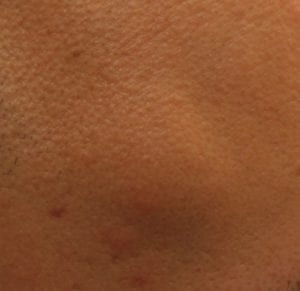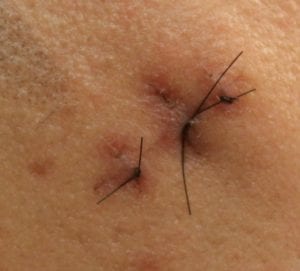Best Cyst Removal Los Angeles: What causes cysts? Skin cysts or sebaceous cysts are common and non-cancerous bumps that develop under the skin, usually filled with liquid or semi-liquid sebum forms. They often appear on the face, back, ears, scalp, or scrotum. They are also considered benign cysts that are unsightly and sometimes painful. If you notice a stubborn lump growing beneath the skin, and it hasn’t reduced or subsided for some time, you likely need to see a dermatologist for cyst removal. In many cases, it is impossible to get rid of a cyst naturally or without intervention to drain the trapped fluid.
A few methods for safe and nearly painless cyst removal at a dermatologist’s office, like the Dr. U Hair and Skin Clinic in Los Angeles. Removal is non-invasive, but the wound may take some time to heal depending on the method used and the size of the cyst removed.
What Causes Cysts?
What is a cyst: A sebaceous cyst can develop from acne, an infected hair follicle, cellular defects, chronic inflammatory disorders, blockages of ducts in the body, or injury where the cyst emerges. They form when fluid, air/gases, debris, dead skin cells, bacteria, or pus get trapped inside the pores of your skin.
What causes cysts are factors similar to the causes of pimples, but the pore becomes plugged, and the trapped matter cannot escape. Often, this happens when the skin gets damaged by the person squeezing the bump to get rid of a cyst. The affected pore then balloons out and can continue to swell from infection. If left untreated, cysts can vary significantly, growing as small as a pea or as large as a golf ball. At this point, medical cyst removal is the only option to get rid of a cyst.

Can Benign Cysts Grow Anywhere Else or Become Cancerous?
Best Sebaceous Cyst Removal Los Angeles: A sebaceous cyst is the most noticeable of all benign cysts because it grows directly beneath the skin. However, a cyst can grow anywhere in the body. These sac-like pockets can form in our internal tissue, organs, and bones. In these instances, the cyst will likely subside over time. If the internal cyst causes severe pain or obstruction, medical intervention or surgery would be required.
It is extremely rare for benign cysts to become cancerous. A more significant concern is determining that the lump you’ve found is a cyst, not a malignant swelling. This is another critical reason to see a dermatologist early on if you discover a bubble that won’t go away.
Can I Get Rid of A Cyst at Home?
According to Dr. Umar (Dr.U), it is not safe to get rid of a cyst at home. To naturally rupture the cyst, you may try natural topical solutions, such as hot compresses, tea tree oil, castor oil, or aloe vera. Still, any attempt to remove or lance the growth will likely result in a recurrence and increased chances of infection. The best thing you can do is keep it clean and consult a dermatologist. Many people think a sebaceous cyst will subside once the fluid is drained. However, the entire infected pocket, or sac, must be removed to ensure the cyst does not grow back.
This information is essential for critically evaluating online DIY videos and tutorials instructing cyst removal at home. Following these steps are not likely to produce long-term results and may cause complications.
Instead, make an appointment with your dermatologist to safely remove any benign cysts.
Dr. U Explains Medical Methods of Benign Cyst Removal
First, the dermatologist will clean the infected area, followed by a local lidocaine injection to numb the area. This initial injection will sting or cause mild pain. After that, the procedure will be painless. Any of the following methods only take about 30 minutes or less.
Aspirating the Cyst
Aspirating the cyst relieves the fluid pressure and causes the cysts to collapse. Dermatologists and physicians commonly use this minimally invasive method to remove benign cysts found in the breasts. The cyst will, however, recur with this method.
Draining the Cyst
Draining benign cysts can be done by lancing them with a small incision or by using a needle and syringe to extract the matter from within. If the dermatologist lances the cyst, they will use manual pressure to squeeze out the pus and debris. Your doctor may follow this with a steroid injection to help prevent inflammation. The cyst will also recur with this method.
Surgically Removing the Cyst
The only permanent method of treating cysts is surgical removal. The dermatologist will surgically excise the entire lump as a cyst removal. This extracts all causal cells, including any debris, pus, and the membranous tissue or sac. Once the cyst has been removed, the doctor will stitch the wound closed.

Cyst Removal Los Angeles Cost
The cost to remove a sebaceous cyst in Los Angeles depends on the clinic, but it is relatively low compared to other cosmetic procedures.
It is always recommended to undergo cyst removal under the supervision and hands of a trusted dermatologist.
Home Care After Removal of a Sebaceous Cyst
What is the healing process like after your cyst has been removed? Depending on the size and depth of the cyst, and the extraction method used, healing will take anywhere from two to four weeks. If the physician removed the cyst surgically but opted for natural wound closure instead of stitches, the wound could take months to heal.
Most people can resume strenuous activity after those two to four weeks and should not attempt to do so any earlier. If your surgical excision were closed with stitches, you would need to tend to the incision as instructed by your doctor properly. This should involve simply keeping the area clean and dry, changing the wound dressing as necessary, and keeping an eye on any inflammation that could be a sign of infection.
While healing from cyst removal, take heed of the instructions from your doctor; take all prescribed medications as directed, such as painkillers or antibiotics.
Cyst Removal Treatment Services by Dr. U in Los Angeles
If you are in the Los Angeles area and experiencing concerns over a cyst issue, schedule a consultation to speak to Dr. Umar of the Dr.U Hair and Skin Clinic by clicking the button below:
Frequently Asked Questions – Cyst Removal
How do I know if I have a sebaceous cyst?
If you find a lump beneath your skin, the only way to determine that it’s a sebaceous cyst is to present it to a doctor. In particular, if the lump has been there for some time and will not subside with hot compresses and topical treatments, you need to get the lump looked at for diagnosis and cyst removal. Once you’re at the doctor’s office, they will most likely be able to diagnose the lump by palpating the area. If a physical exam does not suffice (or if the cyst is internal), your doctor will use imaging with ultrasound, X-ray, MRIs, and CAT scans. They may also need to biopsy the tissue if there is any concern for malignant cells.
After getting rid of a cyst through medical intervention, will the wound leave a scar?
Scarring depends on the extraction method used and the size of the cyst. Typically, healing will result in a small scar if draining or surgical excision is used.
Can what causes cysts be prevented?
This is different for every individual and depends on what causes cysts. Most cysts are not preventable. Many other causes range from chronic inflammatory disorders to infected hair follicles. If you tend to get benign cysts simply from developing a severe acne condition or ingrown hair and then squeezing it too hard, this is a cause that can easily be prevented.
Is Cyst Removal Painful?
Cyst removal itself is not painful. However, the initial anesthesia injection will cause a sting or pressurized sensation that many people consider slightly painful. Once the local anesthesia wears off, you may feel no pain to considerable pain during the healing process. If healing is painful for you, talk to your doctor about pain management options.
Are you interested in learning more about cysts and cyst removal? Dr. U has all of the answers you seek. Click the button below to ask any additional questions you may have:

